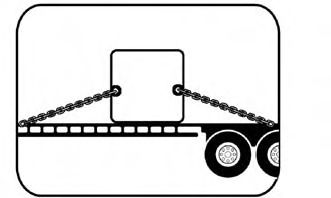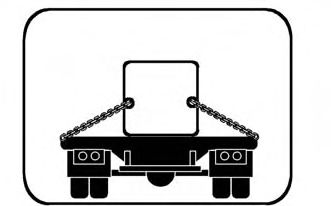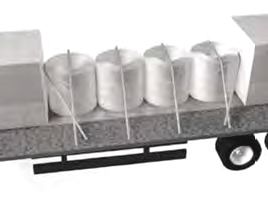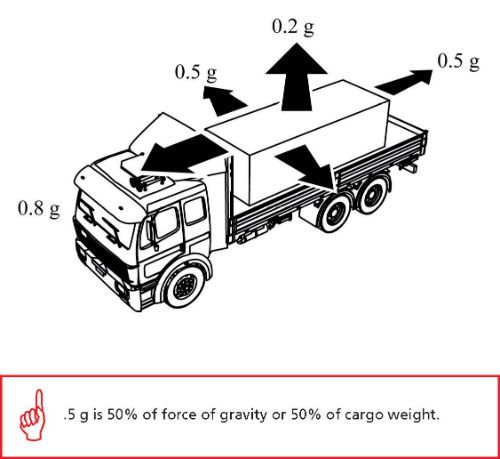CDL Practice Tests: New York State Coil Endorsement
Choose A Section:
Go!How many tiedowns are required for cargo that is prevented from forward movement?
- 2
- 2 every 10ft, or part thereof.
- 1 every 10ft, or part thereof.
- It depends on the weight.
When cargo is prevented from forward movement (for example, by the headboard, bulkhead, other cargo, or tiedown), secure the cargo according to the following requirements:

All Cargo:
1 tiedown for every 10 ft, or part thereof.
What is the maximum ideal angle for an effective direct tiedown?
- 45 degrees.
- 90 degrees.
- 30 degrees.
- 100 degrees.

A direct tiedown is considered effective against forward and rearward forces if it makes an angle less than 45 degrees when viewed from the side of the vehicle.

A direct tiedown is considered effective against side-to-side forces if it makes an angle less than 45 degrees with the horizontal when viewed from the front or rear of the vehicle.
It is accepted that friction mats provide a resistance to horizontal movement equal to:
- 100% of cargo weight.
- 10,000 lbs.
- 50% of cargo weight.
- 20% of cargo weight.
Note: Friction mats provide a resistance to horizontal movement equal to 50% of the cargo weight that is resting on the mat.
A securement system must be capable of resisting how much lateral (side-to-side) force, at minimum?
- 100% of the cargo weight
- 50% of the cargo weight
- 80% of the cargo weight
- 20% of the cargo weight
- The forward force (80% of the cargo weight) represents braking while driving straight ahead.
- The rearward force (50% of the cargo weight) represents vehicle acceleration or braking in reverse.
- The side-to-side or lateral force (50% of the cargo weight) represents traveling on a curve, ramp or changing lanes.
- The vertical force (20% of the cargo weight)) represents cargo vibration during transport. This requirement is satisfied when the cargo is "Fully Contained"
.5g is equal to what?
- 50% of cargo weight.
- 5% of cargo weight.
- 100% of cargo weight.
- 5,000 lbs.
g:
The acceleration due to gravity, 9.823 m/sec2 (32.2 ft/sec2). For cargo securement purposes it is expressed as a percentage of cargo weight, i.e. .5g is 50% of force of gravity or 50% of cargo weight.
What is the aggregate WLL of two indirect tiedowns with a WLL of 5,000 lbs, and one tiedown with a WLL of 6,000 lbs?
- 16,000 lbs.
- 5,000 lbs.
- 10,000 lbs.
- 8,000 lbs.
The aggregate working load limit of all indirect tiedowns is the sum of the working load limits of each indirect tiedown.
A dunnage bag is:
- Material used to fill a void between articles of cargo and the structure of the vehicle that has sufficient strength to prevent movement of the articles of cargo.
- A waterproof sheet used to cover cargo.
- An inflatable bag intended to fill otherwise empty space between articles of cargo, or between articles of cargo and the wall of the vehicle.
- A device placed between the deck of a vehicle and car or between articles of cargo, intended to provide greater friction than exists naturally between these surfaces.
Dunnage bag:
An inflatable bag intended to fill otherwise empty space between articles of cargo, or between articles of cargo and the wall of the vehicle.
Who is responsible for ensuring that the vehicles, anchor points and other securement components are in good working order?
- The DOT and the FMCSA.
- The carrier and driver
- The driver and shipper.
- The shipper and carrier.
Cargo Securement Responsibility:
According to federal and state regulations, the carrier and driver are responsible for ensuring that the vehicles, anchor points and other securement components are in good working order, with no obvious signs of damage. The driver is also required to conduct a pre-trip inspection by other operating regulations.
A 'hook-lift container' is:
- A platform or tray on which cargo is placed so that it can be handled as an article. (Same as "Skid")
- A vehicle especially built and fitted with locking devices for the transport of intermodal containers.
- A specialized container, primarily used to contain and transport materials in the waste, recycling, construction/demolition, and scrap industries, which are used in conjunction with specialized vehicles, in which the container isloaded and unloaded onto a tilt frame body by an articulating hook-arm.
- A reusable, transportable enclosure that is especially designed with integral locking devices that secure it to a container chassis trailer to facilitate the efficient and bulk shipping and transfer of goods by, or between various modes of transport, such as highway, rail, sea, and air.
Hook-lift Container:
A specialized container, primarily used to contain and transport materials in the waste, recycling, construction/demolition, and scrap industries, which are used in conjunction with specialized vehicles, in which the container isloaded and unloaded onto a tilt frame body by an articulating hook-arm.
Whenever possible, a row of metal coils with eyes vertical requires one direct tiedown to secure against rearward movement at what minimum angle?
- 180 degrees.
- 90 degrees.
- 30 degrees.
- 45 degrees.

At least one direct tiedown against the front of the row of coils, restraining against forward motion, and if practicable, making an angle 45 degrees or less with the floor.
At least one direct tiedown against the rear of the row of coils, restraining against rearward motion, and if practicable, making an angle 45 degrees or less with the floor.
About The New York State Coil Exam
You must have a New York State coil endorsement if you want to haul metal coils in New York.
Performance Criteria for Securement Systems:
Part I: Cargo Securement Performance Criteria
The standard provides the minimum amount of force that cargo should be expected to withstand, in each direction, as shown below.
These minimum force requirements, called the “performance criteria”, were determined after extensive testing. The securement system MUST be capable of resisting these forces, as shown below.
- The forward force (80% of the cargo weight) represents braking while driving straight ahead.
- The rearward force (50% of the cargo weight) represents vehicle acceleration or braking in reverse.
- The side-to-side or lateral force (50% of the cargo weight) represents traveling on a curve, ramp or changing lanes.
- The vertical force (20% of the cargo weight)) represents cargo vibration during transport. This requirement is satisfied when the cargo is "Fully Contained"

The performance criteria may also be expressed in terms of acceleration, which is shown at right (“g” is the term used for gravity, and represents acceleration or deceleration).
- 0.8 g deceleration in the forward direction.
- 0.5 g deceleration in the rearward direction.
- 0.5 g acceleration in a side-to-side or lateral direction.
- 0.2 g vertical acceleration.
EXAMPLE: If a steel coil weighs 10,000 lbs., the load securement must provide 8,000 lbs. of securement to prevent movement in the forward direction, which is expressed as 80% of the cargo weight (or 0.8 g).
PART II - Performance Criteria for Components of a Securement System
Each component of the cargo securement system should not exceed its Working Load Limit (WLL), when at maximum force. The Working Load Limit is the maximum load that may be applied to a component of a cargo securement system during normal service; it is usually assigned by the manufacturer of the component.
Each force in the performance criteria is to be applied separately to the securement system to determine if it is compliant.
 Cargo Securement Terms That Truck Drivers Should Know:
Cargo Securement Terms That Truck Drivers Should Know:
-
Working Load Limit (WLL):
The maximum load that may be applied to a component of a cargo securement system during normal service, usually assigned by the manufacturer of the component.
-
g:
The acceleration due to gravity, 9.823 m/sec2 (32.2 ft/sec2). For cargo securement purposes it is expressed as a percentage of cargo weight, i.e. .5g is 50% of force of gravity or 50% of cargo weight.
-
Contained:
Cargo is contained if it fills a sided vehicle, and every article is in contact with or sufficiently close to a wall or other articles so that it cannot shift or tip if those other articles are also unable to shift or tip.
-
Tiedown:
A combination of securing devices which form an assembly that attaches cargo to, or restrains cargo on, a vehicle or trailer, and is attached to anchor point(s).
Vehicle Structure and Anchor Points
The vehicle must be strong enough to resist the forces in the performance criteria (Section 1). The vehicle must be appropriate for the cargo it is to transport, or it must be adapted to be suitable by using fittings, fixtures, dunnage, cribbing or other means.
Cargo Securement Responsibility
According to federal and state regulations, the carrier and driver are responsible for ensuring that the vehicles, anchor points and other securement components are in good working order, with no obvious signs of damage. The driver is also required to conduct a pre-trip inspection by other operating regulations.
Roadside inspections are conducted in accordance with federal, state and provincial laws. If securement equipment fails inspection, it is likely that the vehicle may be placed out-of-service, and the motor carrier and/or the driver may be fined.
Questions you should be able to answer:
- What is the definition of working load limit?
- What do they call a waterproof sheet used to cover cargo?
- What is a cab shield?
- Whenever possible, a row of metal coils with eyes vertical requires one direct tiedown to secure against rearward movement at what minimum angle?
- What is the minimum angle that indirect tiedowns must form with the vehicle?
- What does "fully contained" means?
- What is blocking used for?
- What is an anchor point?
- What is a friction mat used for?
- Indirect tiedowns create what direction of force?
- How many tiedowns are required for cargo that is prevented from forward movement?
- What is the minimum number of tiedowns required through the eye of a metal coil loaded crosswise?
- What is a bulkhead used for?
- By definition, what is a wedge?
- What is aggregate working load limit?
- What is the maximum ideal angle for an effective direct tiedown?
- In cargo securement, what is bracing?
- What is a rub rail?
- A row of metal coils loaded with eyes lengthwise requires how many direct tiedowns over each side-by-side row or coil?







 TT On Facebook
TT On Facebook